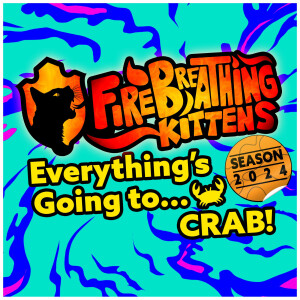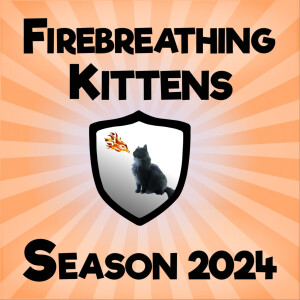
How to play Everything’s Going To Crab.
Hi everyone, this is a special episode of Firebreathing Kittens. I’m the game master for an upcoming session using the rules for Everything Is Going To Crab. This episode is a summary of what I learned after reading the rule book. Hopefully this will be a handy guide for how to play for my players, will help me organize myself, and will be useful for you listeners, too, who are looking to play Everything Is Going To Crab yourselves.
The sections I’ll talk about are:
-
Writing prompt
-
Character creation
-
How to use skills
-
How to attack
Writing prompt: The general idea of this system is that you start in your normal forms and must turn into a crab if you want to survive a giant wave that will hit your town in 24 hours. If you can convince a Non Player Character (NPC) that they need to become a crab, too, then they’ll head to the beach and do their best, and will also survive. The more NPCs you can save, the better. How good are you at convincing people of something they don’t want to believe? This games finds out.
Character creation: There are three categories of traits: eyes, hands, and feet. Each has analogies in your starting and crab forms. Eyes in your starting form, versus crab eyes stalks. Hands in your starting form, versus crab pincers. Feet in your starting form, versus crab legs. Eyes are used for guessing at how much someone believes you that they need to turn into a crab, or reading a book or a town sign. Crab eyestalks are good at seeing through disguises and spotting hidden predators. Hands are used for repairing broken items and high fiving someone, while crab pincers are good at holding on to someone against the might of the sea or snipping something small. Feet are used for driving a car, walking in high heels, and sneaking, while crab legs are good at climbing up rock walls and for scampering at speed. To create your character, put 100 percentage points each into these three categories. Split the percentage points between your current and crab form. The maximum you can start with is 79 percent crab during character creation. Please start with fewer than 80 on the crab side so you don’t have to explain why you look like a crab at the start of the game.
Here is an example. Yolanda puts 70 percent into eyes, and 30 percent into crab eye stalks. She puts 60 percent into hands, and 40 percent into crab pincers. Lastly, she puts 75 percent into feet and 25 percent into crab legs. Yes, you can start with 100 percent in the starting form traits.
How to use skills: Rolling lower than your trait means you succeed in what you try to do. If Jerome wants to spot a hidden lever, he’d roll a d100 and try to roll lower than his crab eyestalks, which are good at spotting things, like hidden levers. With 50 percentage points in eyestalks, a 40 would succeed and a 90 would fail.
As you play, your points will change. After every roll, you can change your ratio from starting body to crab body in one category. 80% will trigger a metamorphoses into that type of form for one limb, 100% will metamorph both limbs. At the end of the game you need to have 80% in all three crab traits to survive the giant wave.
For example, Jerome just finished rolling to spot a hidden lever. Because he rolled, he can choose to adjust the percentage points. He’d previously had 50 points in eyestalks. With the end of the game and the giant wave approaching, Jerome decides to bump his eyes up to 80%, triggering a form change and he describes how one eye pops out into a crab eyestalk. Because he’s above 80 in all traits now, he will survive the giant wave. If he wants both eyes to be eye stalks, he could change his number to 100%.
How to attack: The wave wasn’t just a naturally occurring event, but a planned apocalypse designed to wipe the town off the face of the earth. Some of the townspeople are imposters, and are secretly crabs. You might find yourself in combat with them. Combat rolls are opposed checks. The enemy has between 40 and 70% in each trait. If both you and your enemy succeed your roll, then the person who rolled closer to their trait’s number wins. Players win ties.
Here is an example. JimBob the harbormaster is secretly a crab. You want to spread a rumor about him so that everyone in the town believes the coming wave is JimBob’s fault. Seeing through lies is a starting form eyes trait, so you have to roll a d100 and try to get below your starting form eyes percentage. JimBob still looks human at this point, so he has to roll under a 70 to succeed. He rolls a 20, which is 50 points under, and passes his roll. You’ve been slowly turning into a crab this whole time, and your eyes are mostly eye stalks at this point. You’ve only got 20 point in eyes; it’s 80% eyestalk. You cross your fingers and roll your dice, and you get a 15. That’s a success. It’s five points below its trait number. Both opposed checks succeed, so the one that is closer to its trait number wins. Because you rolled five points below your trait number and JimBob the harbormaster rolled fifty, you are closer, and your rumor is successful. The two NPCs, JimBob’s harbor attendant employees, who had been listening to JimBob’s advice to stay in town, believe your rumor and skedaddle on a boat, escaping the wave.
Hopefully this little rules chat helps my players build their characters and understand combat a bit. And for everyone listening, hopefully now you’re excited to find the Everything Is Going To Crab rule book yourself, and play a game with friends. I’m looking forward to playing Everything Is Going To Crab in an upcoming adventure.
More Episodes
 2024-07-10
2024-07-10
 59
59
 2024-07-03
2024-07-03
 102
102
 2024-07-03
2024-07-03
 51
51
 2024-06-26
2024-06-26
 130
130
 2024-06-26
2024-06-26
 49
49
 2024-06-19
2024-06-19
 170
170
 2024-06-19
2024-06-19
 54
54
 2024-06-19
2024-06-19
 68
68
 2024-06-12
2024-06-12
 100
100
 2024-06-12
2024-06-12
 60
60
 2024-06-05
2024-06-05
 123
123
 2024-06-05
2024-06-05
 56
56
 2024-06-05
2024-06-05
 57
57
 2024-06-05
2024-06-05
 55
55
 2024-05-29
2024-05-29
 94
94
 2024-05-29
2024-05-29
 54
54
 2024-05-22
2024-05-22
 127
127
 2024-05-22
2024-05-22
 57
57
 2024-05-22
2024-05-22
 62
62
 2024-05-18
2024-05-18
 95
95
Create your
podcast in
minutes
- Full-featured podcast site
- Unlimited storage and bandwidth
- Comprehensive podcast stats
- Distribute to Apple Podcasts, Spotify, and more
- Make money with your podcast
It is Free
- Privacy Policy
- Cookie Policy
- Terms of Use
- Consent Preferences
- Copyright © 2015-2024 Podbean.com






